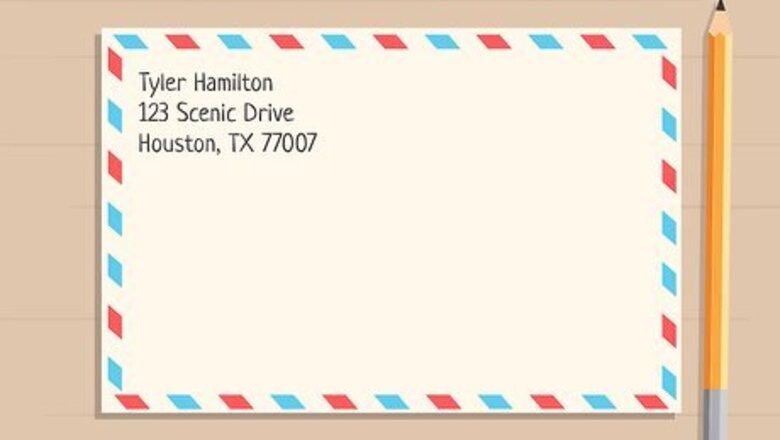
views
Writing an Address on an Envelope
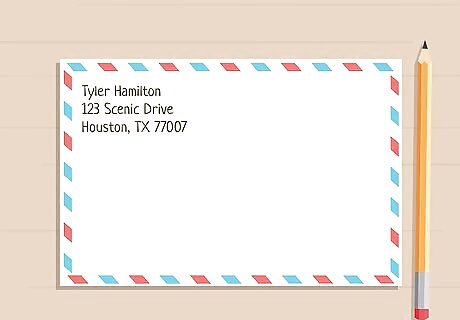
Put your name and address in the top left corner of the envelope. It’s important to put your own address on the letter so the post office can return it if it can’t be delivered. Use a pen or pencil to write your name in the top left corner of your envelope. Under your name, write your street address or P.O. box. Below your street address, put your city, state, and zip code. You’d write your address like this: Tyler Hamilton 123 Scenic Drive Houston, TX 77007
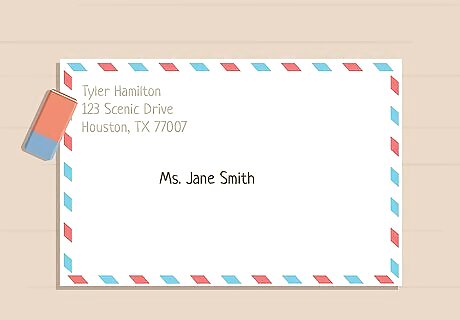
Write your recipient's full name in the middle of the envelope. Include the person’s preferred title, such as Mr., Ms., or Dr. Then, spell out their first and last name, capitalizing the first letter of each name. If you’re writing to a couple, provide both of their names unless they prefer to be addressed as Mr. and Mrs. For a family, write out the family name for a casual letter, such as “The LaCour Family.” If you’re sending a formal letter to a family, write the parents on the first line with their titles, then write the children’s names on the line below the parents. You might write, “Mr. Micah and Ms. Sarah Smith” on the first line and “Callie, Mindy, and Seth” on the second line.
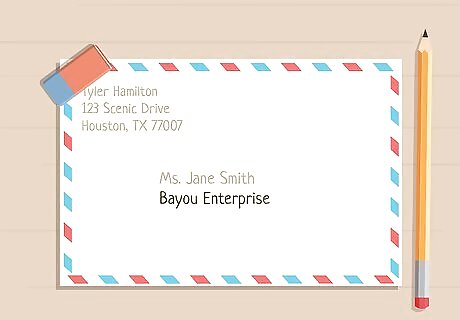
Include the company name on the next line for a business letter. You don’t need to write the company name if you’re writing a personal letter. However, it can help your letter reach the correct person at a business if you’re writing a letter for work. Put the company name on the line below the recipient’s name. You might write, “University of Houston” or “Bayou Enterprises.”
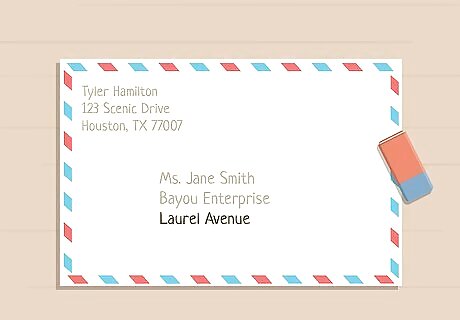
Put the recipient’s street address or P.O. box directly below their name. Write the number of the street address first, followed by the street name. Spell out the entire street name rather than abbreviating it if you’re writing a business or formal letter. Additionally, capitalize the first letter of each word. As an example, you’d write “Laurel Avenue” rather than “Laurel Ave.” in a business letter or formal. If you’re writing a personal letter, it’s okay to write “Hamilton St.” or “Liberty Ln.”
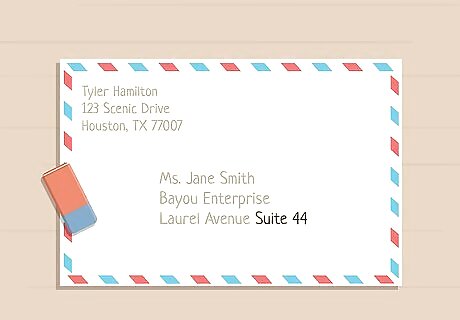
Write an apartment or office number on the address line or below it. Some addresses include an apartment or office number. To ensure your letter arrives, include this information right after the street name or on the line below it. Label an apartment as “apt.” or “apartment.” Put “office” or “suite” if you’re sending the letter to a workplace. You might write: 123 Liberty Lane Apt. 3. or 555 Laurel Avenue Suite 44.
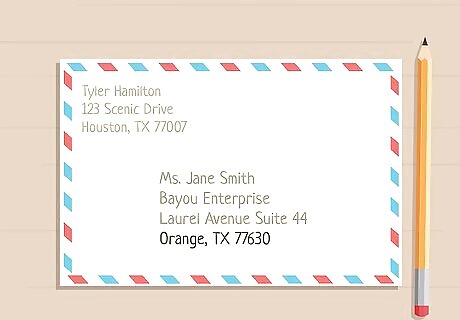
Include the city, state, and zip code below the street address. Directly below the street address, write out the city, followed by a comma. Then, put the state and zip code. Be sure to capitalize the city and state. For instance, you'd write, "Orange, TX 77630."Tip: Each zip code has an extra 4-digit code that comes after it. You can find the extra 4 digits by typing the zip code into the USPS website. If you write these digits on your envelope, your letter will arrive at its destination faster.
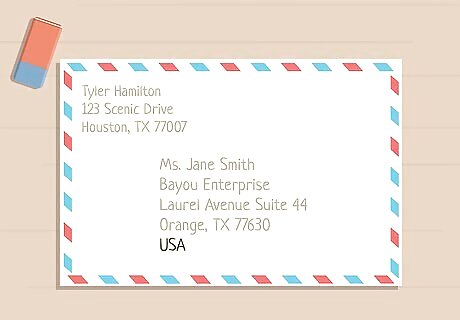
Write the country name after the address for an international letter. You only need to include the country if you’re sending international mail. If so, put the name of the country where your recipient lives directly below their address. Write out the name or abbreviation for the country using all capital letters. You might write, “USA” or “UNITED KINGDOM.”

Put a postage stamp in the top right corner of the envelope. The postal service won’t deliver your mail unless you include postage. Affix a stamp to the top right corner of your envelope to make sure it reaches its destination. If you’re mailing a letter internationally, use an international stamp for correct postage.
Choosing the Right Title for Your Recipient
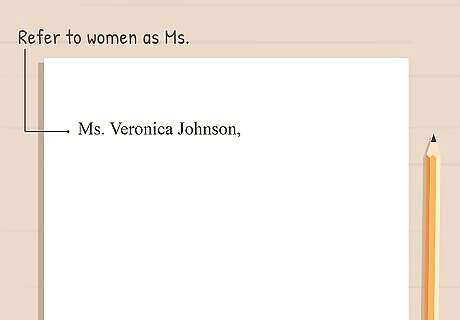
Refer to women as Ms. unless you know they prefer Ms. or Miss. Addressing letters to women can be difficult because etiquette is evolving with gender roles. Ms. is an appropriate title for all women and is the safest option when you're addressing a professional. Always use Ms. as your default title for women. However, use Miss or Mrs. if you know your recipient prefers it. For instance, you’d write Ms. Veronica Johnson or Miss Alyson Meyer.Tip: If you're writing a casual letter, you typically don't need to worry about using titles.
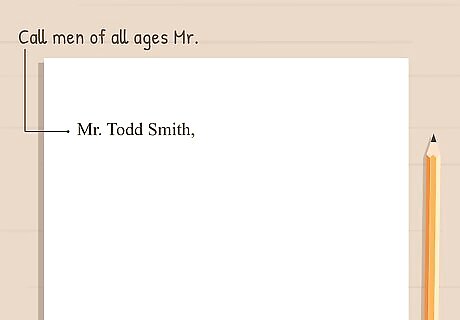
Call men of all ages Mr. It’s easy to address letters to men because you can always use Mr, no matter how old the recipient is. Unless your recipient prefers an alternate title, always use Mr. for a guy. You’d write, “Mr. Todd Smith.”
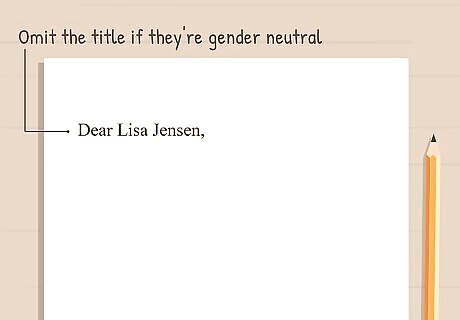
Omit the title if their gender is unknown or they're gender neutral. You may not know someone's gender if you're sending a letter for work or to apply for a job. Similarly, you may sometimes be writing to someone who is gender neutral. If this is the case, it's best to use their full name without a title. It's still considered formal if you write out both their first and last name. You might write, "Dear Lisa Jensen."Variation: Some people who are gender neutral prefer to use the title Mx. Use Mx. if you know the person you're writing to prefers this title.
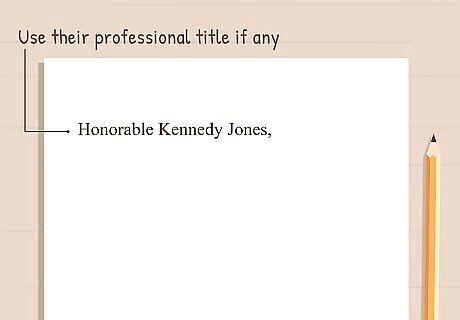
Use your recipient’s professional title if they have one. It’s important to respect professional titles like Dr., Reverend, or Honorable. Address the recipient using their professional title if they have one. Always put the most high-ranking title first if you’re addressing the letter to a couple. You might write “Dr. Ashley Matthews and Mr. Sam Matthews,” or “Honorable Kennedy Jones.”Tip: If you aren’t sure about someone’s title, it’s okay to refer to them by a higher title to be on the safe side. For instance, let’s say you’re writing a letter to a college professor. It’s okay to use “Dr.” as their title even if you’re not sure they have a doctorate.
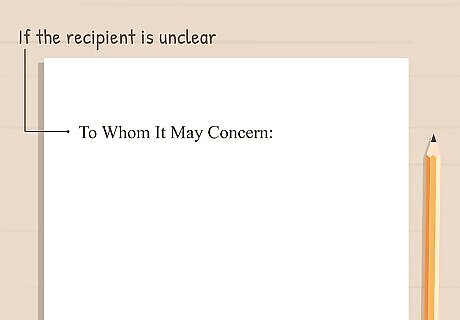
Use a job title or “To Whom It May Concern” if the recipient is unclear. When you’re sending a business or cover letter, you may not know exactly who your recipient is. If this is the case, put the name of the job position that you’re addressing. If you aren’t sure about the job title, use “To Whom it May Concern” as a blanket title. You might write, “Dear Human Resources Manager” if you’re applying for a job. If you aren’t sure there is a human resources manager, you could write, “To Whom It May Concern.”Variation: You might also use the name of the department you’re writing to if you're not sure about the recipient's name or their job title.
Formatting the Top of a Formal Letter
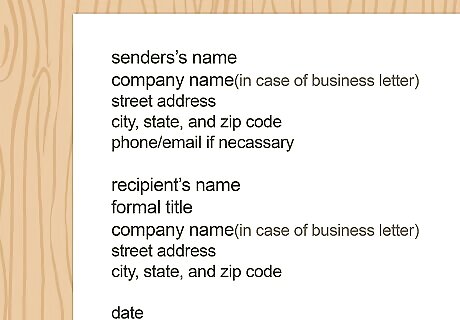
Write your first and last name in the upper lefthand corner of the letter. Use the full, unabbreviated form of your name anytime you’re writing a formal or professional letter. If you have a common name or think there’s a chance that you might be confused with someone else, you might also include your middle initial or another distinguishing feature, like the suffix, “Jr.” When addressing a casual letter to a friend or loved one, it’s alright to use a shortened form of your given name or a nickname, such as “Chuck” or “Shorty.” Some versions of the classic business letter call for the sender’s name to go in the signature at the bottom of the letter rather than at the top of the return address. Both formats are acceptable—go with whichever one you prefer.Tip: Feel free to put your formal title before your first name if you’re a doctor, elected official, or member of the clergy. In this case, you would write, “The Reverend Ichabod Sneed” instead of just, “Ichabod Sneed.”
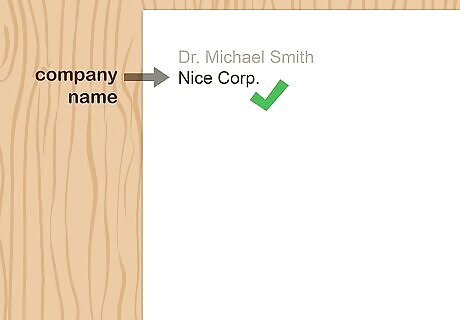
Provide the name of your company on the next line in a business letter. If you're sending out your letter as part of your job, the name of your employer should go on the line directly beneath your name. That way, your recipient will know right off the bat who you represent and why you might be writing. You can also put your official title or position on a separate line below your employer's name if you think it will be helpful to your recipient.Variation: If you've decided to wait until the signature to give your name, the name of your company or business will go on the first line of the sender's address.
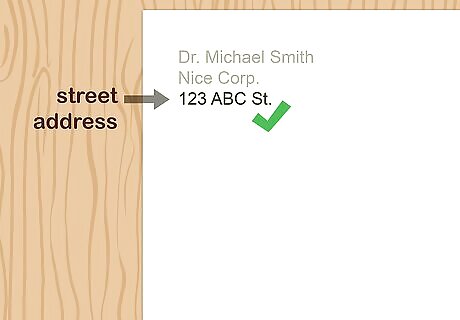
List your street address on the line below your name or company name. Start with the street number, then give the name of the street. Be sure to spell out the full name of the street in your address line. In other words, you would write, “Mulberry Lane,” not, “Mulberry Ln.” Don't forget to include your apartment or office number after your street address, if applicable, as in, "2529 Cypress Row, Apt. 5D." Your address line lets your recipient know where you’re writing from, and also gives them a precise location to which they can address a letter of their own if they wish to write you back.
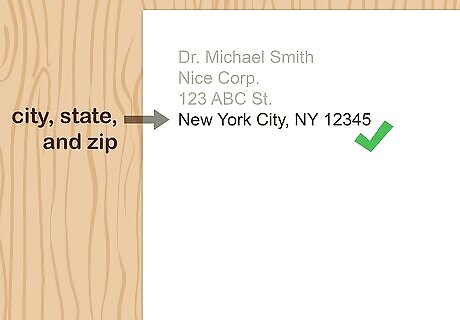
Put your city, state, and zip code beneath your street address. Write the city name first, then put a comma. After the comma, put your state and zip code. Be sure capitalized both your city and state, and spell them correctly. Unlike the city and state, the state and zip code should be separated using only a space: "Santa Carla, California 95000."
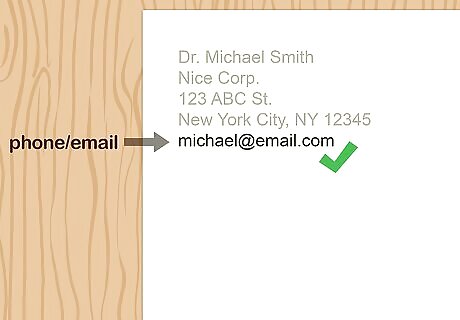
Add your phone number and/or email address if your letter is work-related. It’s best to provide your phone number or email so your recipient has another means of contacting you. If you decide to include both pieces of information, list your phone number first, then write out your email address on a new line. If you want to provide both your work and personal phone numbers, put the second number on a new line and use the prefixes “Work:” and “Cell:” to make it clear which is which. There’s no need to give your phone or email if you’re writing a message you don’t necessarily expect to get a reply to, such as a letter to the editor or a complaint to one of your local politicians.
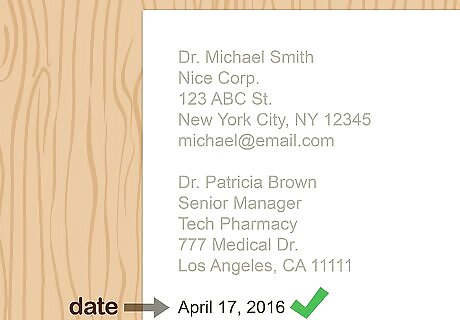
Skip a line and write the date. After your address, leave a space them write the date the date you’re writing your letter. Spell out the full name of the month, then a numerical day and year. For instance, you’d write “November 5, 2019” as opposed to “Nov. 5, 2019” or “11-5-19.” If you composed your letter over the course of multiple days, use the date on which you completed it. While it's not strictly necessary, including the date places your letter within a certain time frame, which can be helpful if it contains time-sensitive information.

Write your recipient’s name on a new line below the date. If you don’t know the person’s full name, it’s alright to use just their last name, along with an appropriate title, such as “Mr.”, “Dr.”, or, “Chancellor.” You can also state your recipient’s title in addition to their full name for more formal or reverent effect, as in “Mr. Peter Walsh.” If your recipient is female and doesn't have a formal title, be sure to use her preferred mode of address (“Ms.”, “Mrs.”, or “Miss”) to avoid seeming presumptuous. If you’re not sure what she ordinarily goes by, the safest choice is always “Ms.” Double-check the spelling of the person’s name to make sure you get it right. Misspelling someone’s name could be perceived as negligent at best and disrespectful at worst.
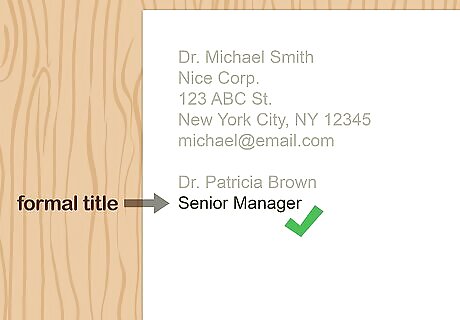
Specify your recipient’s job title if you’re writing a business letter. Use the next line to acknowledge your recipient’s position, office, department, or special authority. The title line builds on the identifying information found in the name line. Keep in mind that you’ll only need to incorporate a title line if your reason for writing has something to do with your recipient’s position or occupation.Tip: If you don’t know the person’s formal title, simply substitute the name of the department or division in which they work.

Include the name of the company your recipient works for in a business letter. On the line below your recipient’s title, give the full name of their employer or the specific entity that they represent. This helps direct your letter to the right person in the correct department. It also indicates that your letter is a formal letter. This line isn’t reserved exclusively for the names of companies and businesses. It can also be used to institutions, such as, “The University of Alabama” or “Hollingsworth Museum of North London.”

Write your recipient’s full address in the following two lines. In a business letter, you’ll use your recipient’s work address, whereas in a personal letter you’ll simply use their home or private address. Be sure to put the city, state, and zip code on a separate line below the street address. Look back over your address lines before mailing your letter to ensure that they’re correct. If you happen to get the street name or postal code wrong, your letter may not get where it needs to go. When addressing an international letter, tack on a final line with the name of the country written in all capital letters.


















Comments
0 comment